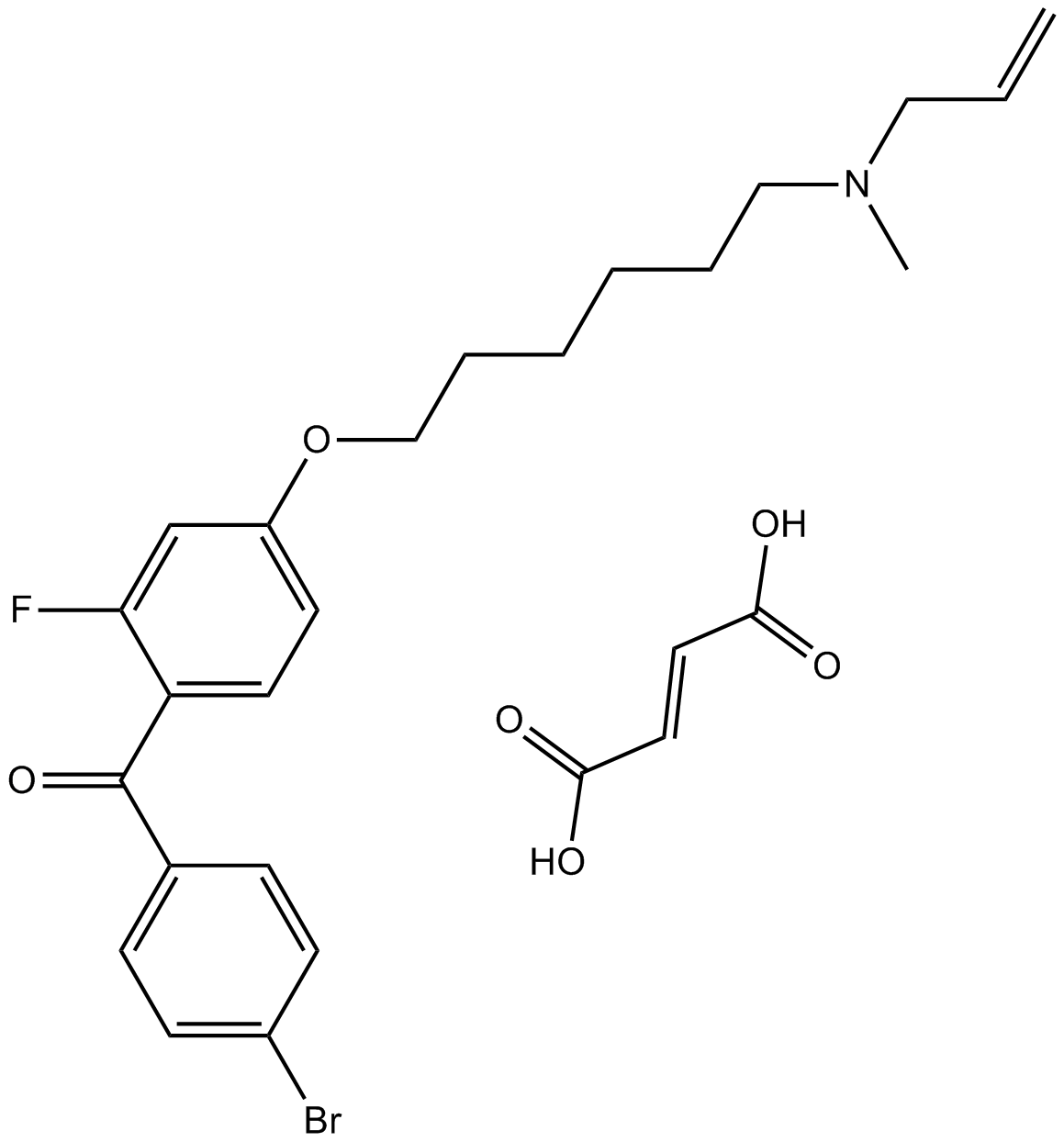Ro 48-8071 fumarate |
| رقم الكتالوجGC17274 |
Ro 48-8071 fumarate هو مثبط لـ OSC (Oxidosqualene cyclase) مع IC50 من appr 6.5 نانومتر
Products are for research use only. Not for human use. We do not sell to patients.

Cas No.: 189197-69-1
Sample solution is provided at 25 µL, 10mM.
Ro 48-8071 fumarate is an inhibitor of OSC (Oxidosqualene cyclase) with IC50 of appr 6.5 nM.
In HepG2 cells, Ro 48-8071 reduces cholesterol synthesis dose dependently with an IC50 value of appr 1.5 nM[1]. Ro 48-8071 (10 μM) significantly reduces the viability of PC-3 prostate cancer cells, but not normal prostate cells. Ro 48-8071 (10-30 μM) induces apoptosis of both LNCaP and C4-2 cell lines in a dose-dependent manner. And castration-resistant PC-3 and DU145 cells also demonstrate significant levels of apoptosis following 24-hour treatment with Ro 48-8071. Ro 48-8071 (10-25 μM) reduces AR protein expression in a dose-dependent manner. Ro 48-8071 (0.1-1 μM) increases ERβ protein expression dose-dependently in both hormone-dependent LNCaP and castration-resistant PC-3 cells[2]. Using mammalian cells engineered to express human ERα or ERβ protein, together with an ER-responsive luciferase promoter, Ro 48-8071 dose-dependently inhibits 17β-estradiol (E2)-induced ERα responsive luciferase activity (IC50, appr 10 µM), under conditions that are non-toxic to the cells[3].
Ro 48-8071 lowers LDL-C maximally appr 60% at 150 μmol/kg per day, with no further reduction up to 300 μmol/kg per day, leaving HDL-C unchanged at all doses in hamsters. Ro 48-8071 (≥00 μmol/kg per day) increases the amount of MOS in liver of hamsters. Ro 48-8071 (300 μmol/kg per day) remarkedly and significantly reduces VLDL secretion of hamsters[1]. Ro 48-8071 (5 or 20 mg/kg) significantly reduces in vivo tumor growth in mice, without weight loss of the mice. Furthermore, Ro 48-8071 at a concentration of 20 mg/kg, completely eradicates two of the 12 tumors being monitored in the mice in the timeframe tested[2]. Ro 48-8071 (20 mg/day/kg body weight) leads to a rapid and sustained inhibition (>50%) of cholesterol synthesis in the whole small intestine of BALB/c mice. Sterol synthesis is also reduced in the large intestine and stomach[4].
References:
[1]. Morand OH, et al. Ro 48-8.071, a new 2,3-oxidosqualene:lanosterol cyclase inhibitor lowering plasma cholesterol in hamsters, squirrel monkeys, and minipigs: comparison to simvastatin. J Lipid Res. 1997 Feb;38(2):373-90.
[2]. Liang Y, et al. Cholesterol biosynthesis inhibitor RO 48-8071 suppresses growth of hormone-dependent and castration-resistant prostate cancer cells. Onco Targets Ther. 2016 May 30;9:3223-32.
[3]. Liang Y, et al. Cholesterol biosynthesis inhibitors as potent novel anti-cancer agents: suppression of hormone-dependent breast cancer by the oxidosqualene cyclase inhibitor RO 48-8071. Breast Cancer Res Treat. 2014 Jul;146(1):51-62.
[4]. Chuang JC, et al. Sustained and selective suppression of intestinal cholesterol synthesis by Ro 48-8071, an inhibitor of 2,3-oxidosqualene:lanosterol cyclase, in the BALB/c mouse. Biochem Pharmacol. 2014 Apr 1;88(3):351-63.
Average Rating: 5 (Based on Reviews and 11 reference(s) in Google Scholar.)
GLPBIO products are for RESEARCH USE ONLY. Please make sure your review or question is research based.
Required fields are marked with *




















